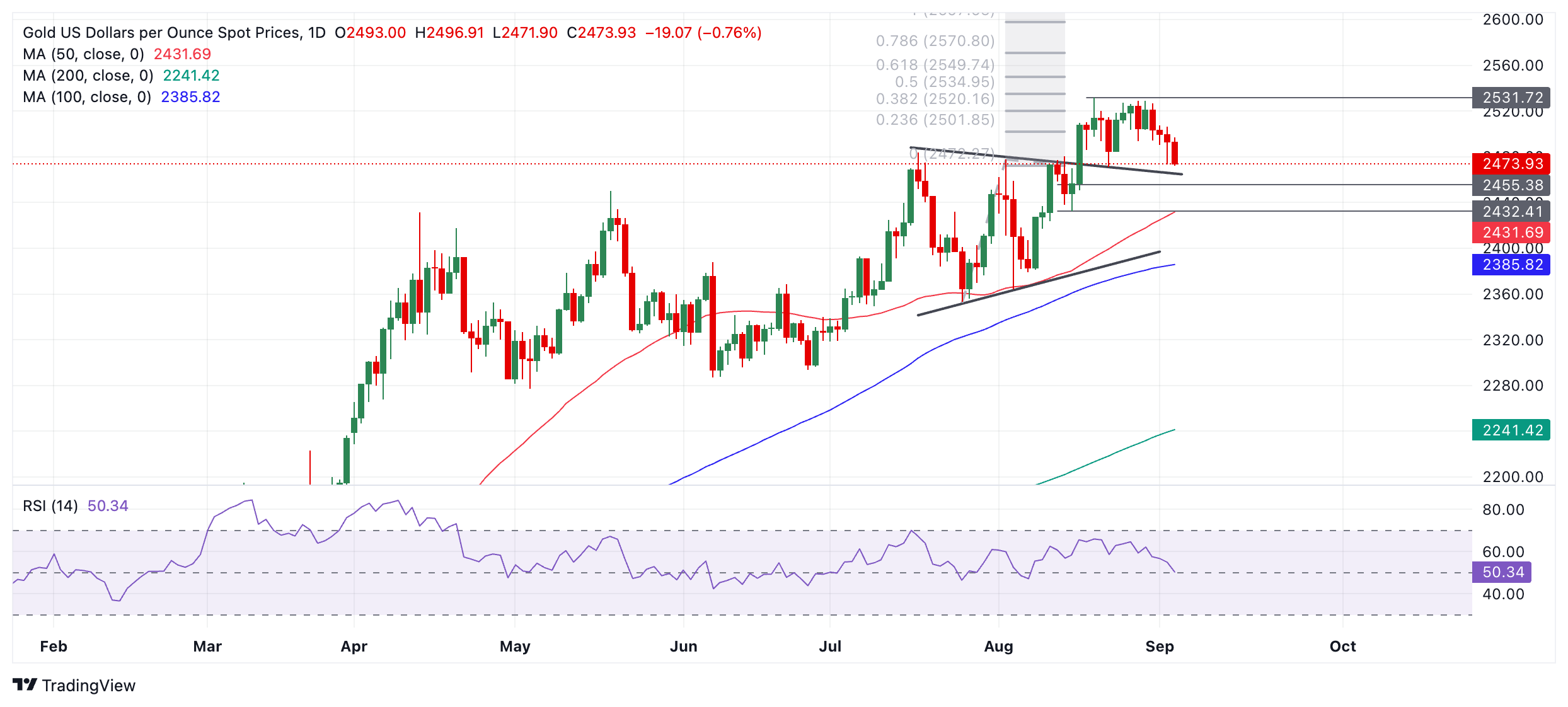Gold continues declining despite global market sell-off

- Gold continues falling despite risk sentiment turning negative following weak US manufacturing data.
- Overcrowded long positioning could be the reason the commodity is not rising as expected.
- Technically, Gold has broken below the key $2,500 level – a bearish sign for the precious metal.
Gold (XAU/USD) trades lower, exchanging hands in the $2,480s on Wednesday. Market sentiment remains negative after the global sell-off triggered by the release of weak US manufacturing data on Tuesday, and fears about the Artificial Intelligence (AI) tech bubble bursting.
Surprisingly, this has failed to translate into upside for Gold despite its safe-haven status, perhaps due to the overweight long positioning of Commodity Trading Advisors (CTA) and institutional investors. Despite the turmoil gripping risk assets Gold actually finished Tuesday down over a quarter of a percent.
Gold shrugs off increased probabilities of a 0.50% Fed rate cut
Gold also fails to capitalize on the significant rise in market-based probabilities of the US Federal Reserve (Fed) opting for a larger 0.50% interest rate cut at its September 18 meeting.
Prior to the release of the weak US Manufacturing PMI print, the CME FedWatch Tool – which uses the 30-day fed fund Futures price to estimate chances of future Fed decisions – calculated the probability of the Fed making a 0.50% cut at around 31%. Today the probability has increased significantly to 41%.
Such a big shift in expectations of interest rates falling would normally be expected to have a bullish effect on Gold since it lowers the opportunity cost of holding the non-interest-paying precious metal. However, on this occasion this does not seem to be the case.
US employment metrics, scheduled for release during the remainder of the week, could still impact the outlook for US interest rates either way. This is particularly the case given recent comments by Federal Reserve (Fed) Chairman Jerome Powell, who highlighted risks to the labor market as now being more important than inflation in his speech at Jackson Hole. This week the data will put his remarks to the test.
Wednesday sees the release of US JOLTS Job Openings, which are forecast to show a decline to 8.1 million in July from 8.184 million in June. A more pronounced decline in openings, however, would raise concerns regarding the state of the jobs market and further increase the chances of the Fed making a larger 0.50% cut.
ADP Employment Change and Jobless Claims follow on Thursday, but the main event on the calendar will be US Nonfarm Payrolls (NFP) on Friday. If NFPs increase less than expected it would further support the case of the larger cut.
On the geopolitical front, there are no major flare-ups that could pass through to increased demand for Gold. Although Russia launched a large missile and drone attack on Ukraine on Tuesday, killing 50 people in Poltava, it follows days of similar bombardments.
Out of Gaza, meanwhile, the Israeli populace continues to protest for a ceasefire to allow the safe release of hostages and the US criminally charged Hamas’s leaders for organizing the October 7 attacks.
Technical Analysis: Continues oscillating in a messy range
Gold (XAU/USD) continues meandering within a messy range below its previous all-time highs of $2,531.
It has now broken below the key $2,500 support level – a bearish turn of events from a technical perspective – but remains above the next key level at $2,470-$2,460, the top of the old range formed in July and early August.
XAU/USD Daily Chart
An as yet un-met upside target for Gold sits at $2,550 and remains active. This was generated after the original breakout from the July-August range on August 14.
Gold’s medium and long-term trends also remain bullish, which, given “the trend is your friend,” means the odds still favor an eventual breakout higher materializing.
A break above the August 20 all-time high of $2,531 would provide more confirmation of a continuation higher toward the $2,550 target.
If Gold continues steadily weakening, however, it is likely to next find support at the $2,470-$2,460 level. A decisive break below that level would change the picture for Gold and suggest that the commodity might be starting a more pronounced downtrend.
Economic Indicator
Nonfarm Payrolls
The Nonfarm Payrolls release presents the number of new jobs created in the US during the previous month in all non-agricultural businesses; it is released by the US Bureau of Labor Statistics (BLS). The monthly changes in payrolls can be extremely volatile. The number is also subject to strong reviews, which can also trigger volatility in the Forex board. Generally speaking, a high reading is seen as bullish for the US Dollar (USD), while a low reading is seen as bearish, although previous months’ reviews and the Unemployment Rate are as relevant as the headline figure. The market’s reaction, therefore, depends on how the market assesses all the data contained in the BLS report as a whole.
